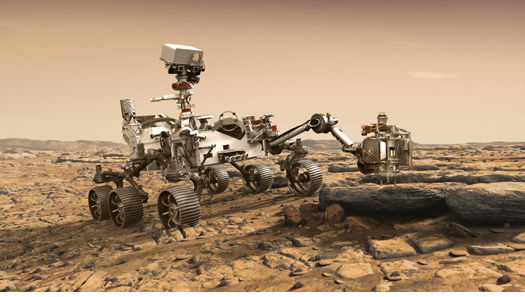On 18 February 2021 Perseverance rover a car sized rover landed inside Mars’ Jezero Crater. NASA released an amazing, high-definition video and pictures that perseverance rover took on this planet. This amazing footage shows Perseverance’s epic ride, even showing the moment the rover still attached via cables. Landing on Mars is quiet difficult. According to acting NASA Administrator Steve Jurczyk said in a statement today 22 February 2021, “Perseverance is just getting started and already has provided some of the most iconic visuals in space exploration history,” Jurczyk added. Perseverance has an EDL camera system which has special microphones built to capture rushing Martian winds and other EDL sounds.
Before Perseverance there has been other robots that where launched to MARS. In August 2012 NASA sent Curiosity rover, which captured imagery of its own. Perseverance and Curiosity employed the same basic landing strategy, relying on a supersonic parachute and a rocket-powered sky crane and other mechanisms to get down safely. Curiosity rover’s EDL footage was not as clear, sharp and complete as the one NASA posted on February 2021 after being captured by Perseverance rover. We got to see Curiosity’s imagery stopped long before the rover touched down. And we didn’t get the range of viewpoints that the Perseverance video provides. The newer mission put multiple EDL cameras on the rover’s protective backshell, one on the bottom of the sky crane and two on Perseverance itself one that looked up and another that looked down. The arrival of perseverance rover on Mars brings back to mind questions that scientists have attempted to answer about the possibility of humans migrating to inhabit the planet Mars. The intent is to bring back perseverance with samples from Mars for further research about the planet.
Can we plant trees on Mars to produce oxygen there because it already has soil?
Scientists claim that MARS is the most possible habitable environment after the EARTH. Mars has a thin atmosphere, with a surface pressure less than a hundredth of the Earth’s. It is 96% carbon dioxide (CO2) and only about 0.1% oxygen (O2). Mars has no organisms in the soil, no anchors to hold the soil down, no existing organisms, no real atmospheric protection, and no stable temperature range for supporting life that exists on Earth, half the sunlight that reaches Earth and a solid core so no means of holding the atmosphere down. Earth’s atmosphere is 21% oxygen (O2). A complex set of organisms similar to the ones we have in organic soil would have to be introduced so that our plant life and from that our animal life can survive.
There are various factors needed to make the environment conducive on planet Mars. Planting trees on MARS is not possible in accordance with the existing technology and existent scientific knowledge. Plants are multicellular eukaryotic organism of Kingdom Plantae. Plants are characterized by sexual and asexual reproduction, modular and an alternation of generations, indeterminate growth. Several factors make the growth of plants conducive on Earth and not on MARS. Plants absorb specific wavelength (680 nm and 700 nm) of sunlight and any light of wavelength above outside this range will be damaging for growth. Temperature plays a very important role in the growth of plants. Enzymes responsible for the metabolic activities in plants are denatured at high temperatures and hence, affect the metabolism in plants.
Water availability is crucial for plant growth through photosynthesis. Water is the most essential reactant used by the plant to prepare starch. Carbon Dioxide (CO2) is also important for the preparation of food by green plants. Humidity plays a very important factor as it controls the transpiration rate. Soil plays an important role as it provides macro and micro nutrients and anchors the plants. Chlorophylls and Carotenoids are the pigments used in plants and they are proteinaceous in nature. At higher temperature the pigments are denatured and this affects the growth. As these conditions are not available on the MARS for the growth of plants, we will not be able to grow plants. The procedure is so cumbersome it may lead to unnecessary lose of money and precious time. This amplifies the question why is MARS not suitable for plant growth and as compared to the EARTH?
